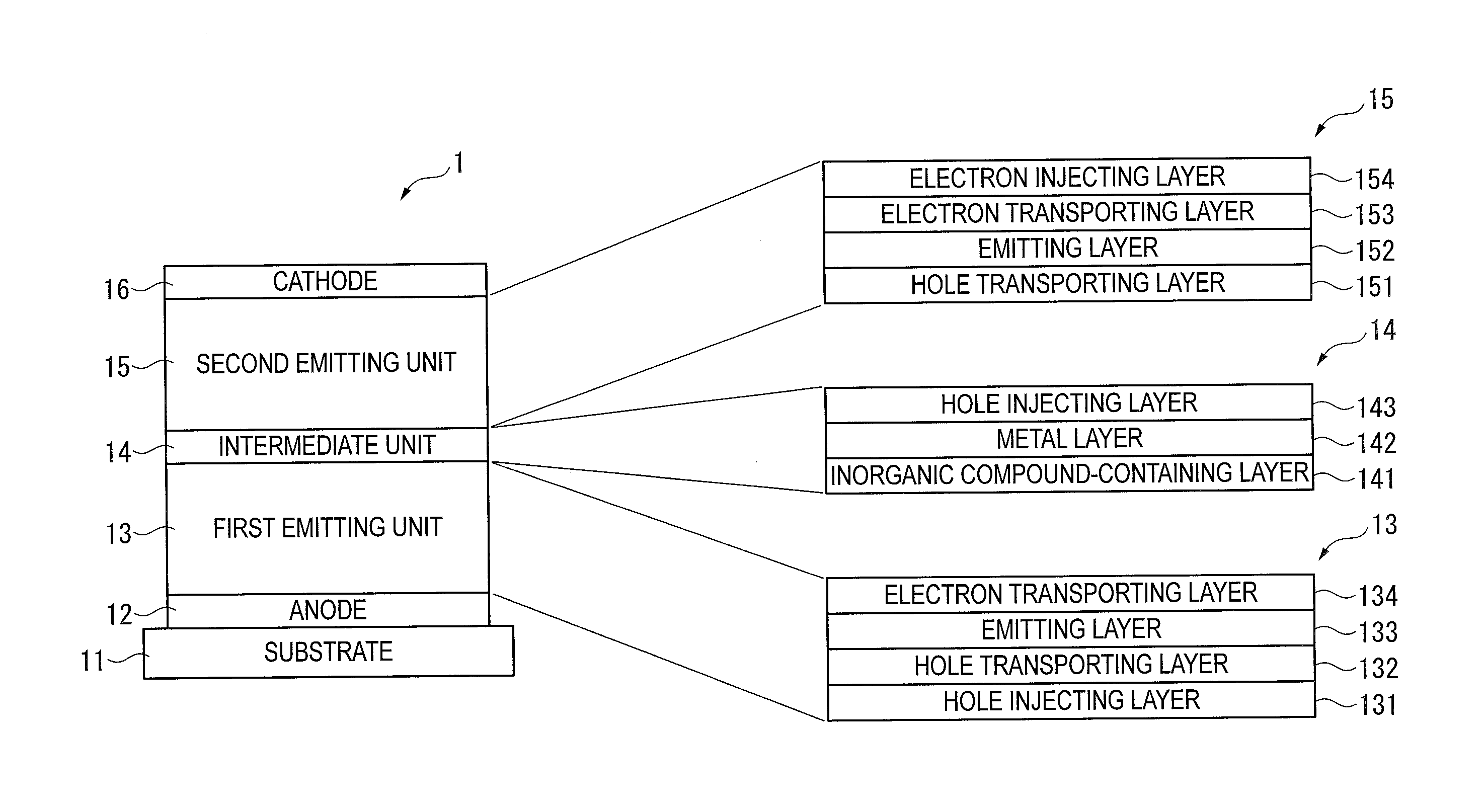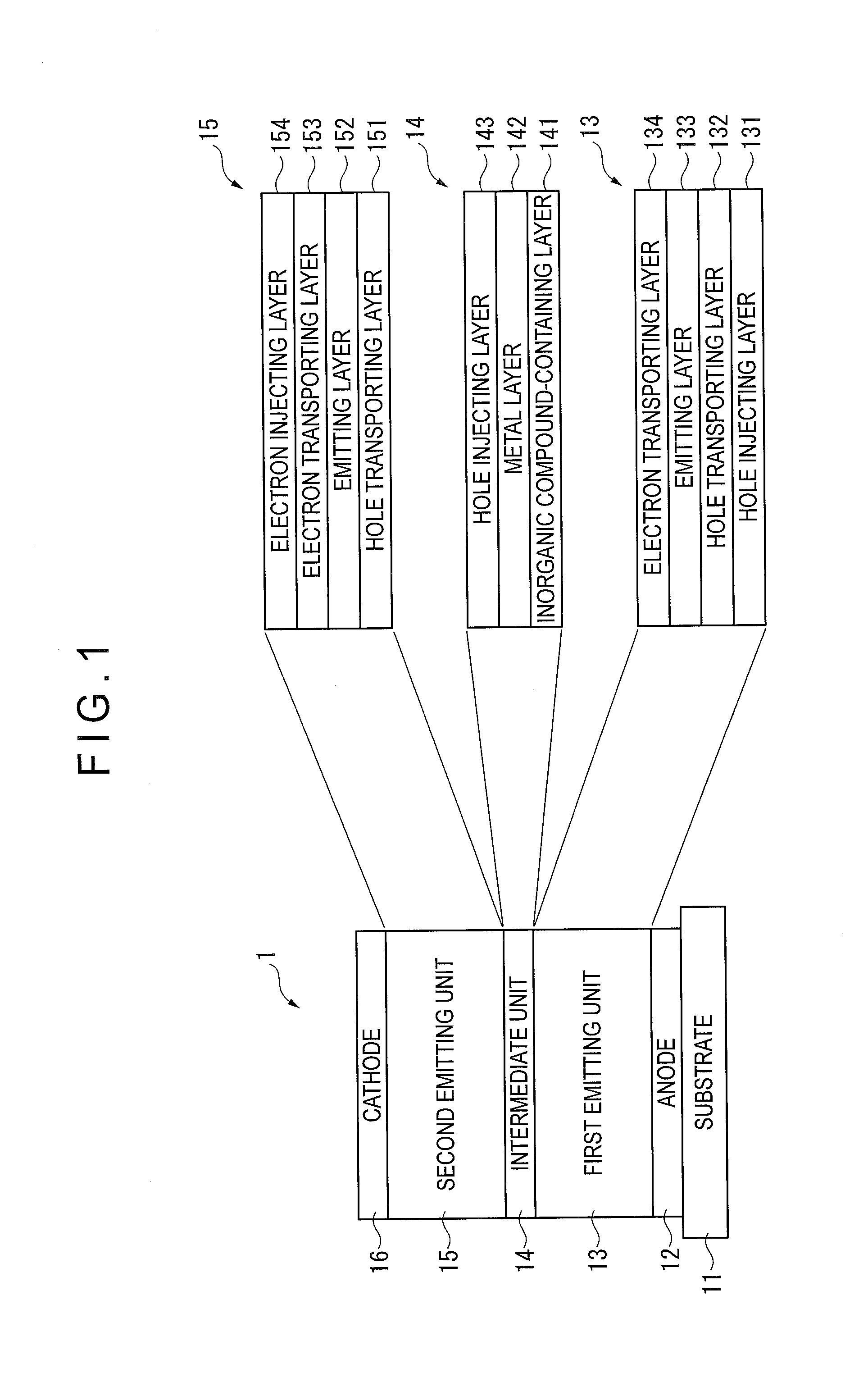Organic electroluminescent element
- Summary
- Abstract
- Description
- Claims
- Application Information
AI Technical Summary
Benefits of technology
Problems solved by technology
Method used
Image
Examples
first exemplary embodiment
[0030]Arrangement of Organic EL Device
[0031]A tandem-type organic EL device includes a plurality of emitting units, e.g., a first emitting unit and a second emitting unit, as follows: anode / first emitting unit / intermediate unit / second emitting unit / cathode.
[0032]In the first exemplary embodiment, a tandem-type organic EL device 1 arranged as shown in FIG. 1 is exemplarily described. The organic EL device 1 is provided by laminating an anode 12, a first emitting unit 13, an intermediate unit 14, a second emitting unit 15 and a cathode 16 on a substrate 11 in this sequence. As shown in FIG. 1, the first emitting unit 13, the intermediate unit 14 and the second emitting unit 15 are respectively provided with a plurality of layers. The arrangements thereof are as follows.
[0033]The first emitting unit 13 includes a hole injecting layer 131, a hole transporting layer 132, an emitting layer 133, and an electron layer 134.
[0034]The intermediate unit 14 includes an inorganic-compound-contain...
second exemplary embodiment
[0192]Next, a second exemplary embodiment is described below.
[0193]In the description of the second exemplary embodiment, the same components as those in the first exemplary embodiment are denoted by the same reference signs and names to simplify or omit an explanation of the components. In the second exemplary embodiment, the same materials and compounds as described in the first exemplary embodiment are usable.
[0194]As shown in FIG. 2, an organic EL device 2 according to the second exemplary embodiment includes three emitting units and two intermediate units.
[0195]The organic EL device 2 is provided by laminating the anode 12, the first emitting unit 13, a first intermediate unit 14A, the second emitting unit 21, a second intermediate unit 14B, a third emitting unit 22 and the cathode 16 on the substrate 11 in this sequence.
[0196]In the second exemplary embodiment, the first intermediate unit 14A and the second intermediate unit 14B each include the inorganic-compound-containing l...
third exemplary embodiment
[0203]Next, a third exemplary embodiment is described below.
[0204]In the description of the third exemplary embodiment, the same components as those in the first exemplary embodiments are denoted by the same names and the like to simplify or omit an explanation of the components. In the third exemplary embodiment, the same materials and compounds as described in the first exemplary embodiment are usable.
[0205]An organic EL device 3 according to the third exemplary embodiment is arranged to be capable of emitting light by three primary colors (RGB): red (R), green (G) and blue (B). As shown in FIG. 3, a red emitting device 3R (red pixel), a green emitting device 3G (green pixel) and a blue emitting device 3B (blue pixel) are formed on a common substrate 31.
[0206]The organic EL device 3 is provided by laminating an anode 32, first emitting unit 33, intermediate unit 34, second emitting unit 35 and cathode 36 on a substrate 31 in this sequence. The first emitting unit 33 and the second...
PUM
 Login to View More
Login to View More Abstract
Description
Claims
Application Information
 Login to View More
Login to View More - R&D Engineer
- R&D Manager
- IP Professional
- Industry Leading Data Capabilities
- Powerful AI technology
- Patent DNA Extraction
Browse by: Latest US Patents, China's latest patents, Technical Efficacy Thesaurus, Application Domain, Technology Topic, Popular Technical Reports.
© 2024 PatSnap. All rights reserved.Legal|Privacy policy|Modern Slavery Act Transparency Statement|Sitemap|About US| Contact US: help@patsnap.com










